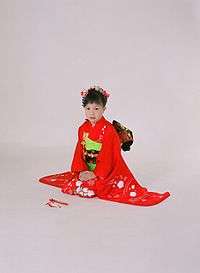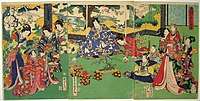Shichi-Go-San
Shichi-Go-San (七五三, lit. "Seven-Five-Three") is a traditional rite of passage and festival day in Japan for three- and seven-year-old girls and five-year-old (and less commonly three-year-old) boys, held annually on November 15 to celebrate the growth and well-being of young children. As it is not a national holiday, it is generally observed on the nearest weekend.
| Shichi-Go-San | |
|---|---|
 Japanese boy at a shrine in Tokyo, dressed up for the Shichi-Go-San festival | |
| Official name | 7-5-3 (shichi go san) |
| Observed by | Japan |
| Type | Ethnic Traditions/Non-Religious/Religious |
| Significance | Traditional rite of passage and festival day in Japan for three- and seven-year-old girls and five-year-old (and sometimes three-year-old) boys |
| Date | November 15 |
History

Shichi-Go-San is said to have originated in the Heian period amongst court nobles who would celebrate the passage of their children into middle childhood. The ages 3, 5 and 7 are consistent with East Asian numerology, which holds that odd numbers are lucky.[1] The practice was set to the fifteenth of the month during the Kamakura period.[2]
Its meaning is to celebrate the survival of children, because in the past people have lost their children due to poor health conditions. So, until the age 7, children were thought to be offspring of Japanese Gods.
Over time, this tradition passed to the samurai class who added a number of rituals. Children—who up until the age of three were required by custom to have shaven heads—were allowed to grow out their hair. Boys of age five could wear hakama for the first time, while girls of age seven replaced the simple cords they used to tie their kimono with the traditional obi.[3] By the Meiji period, the practice was adopted amongst commoners as well, and included the modern ritual of visiting a shrine to drive out evil spirits and wish for a long healthy life.
Current practice
The tradition has changed little since the Meiji period. While the ritual regarding hair has been discarded, boys who are aged five and girls who are aged three or seven are still dressed in kimono—many for the first time—for visits to shrines. Three-year-old girls usually wear hifu (a type of padded vest) with their kimono. Western-style formal wear is also worn by some children. A more modern practice is photography, and this day is well known as a day to take pictures of children. It is common to observe the rite based on the traditional way of calculating age, or kazoedoshi, in which children are one year old at birth and gain a year on each New Year's Day. In this case, girls celebrate in the year in which they would reach an age according to the modern calculation of two or six, and boys in the year in which they would reach an age according to the modern calculation of four.
Chitose ame
Chitose ame (千歳飴), literally "thousand year candy", is given to children on Shichi-Go-San. Chitose ame is long, thin, red and white candy, which symbolizes healthy growth and longevity. It is given in a bag decorated with a crane and a turtle, which represent long life in Japan.[4] Chitose ame is wrapped in a thin, clear, and edible rice paper film that resembles plastic.[5]
In popular culture
- In Crayon Shin-chan episode 26–3, "My Shichi-Go-San", the Nohara family celebrates Shichi-Go-San.
- In the OVA Mega Man: Upon a Star, Roll makes a promise with Akane at a Japanese festival that she will wear a kimono on this event.
- In Mama Loves the Poyopoyo-Saurus episode 11–2, "Shobo-san who came in slobbing mama double", the Poyota family celebrates Shichi-Go-San.
- In Paranoia Agent episode 8, "Happy Family Planning", the character Fuyubachi falls asleep on the train holding chitose ame, which he later gives to the young girl Kamome-kun.
- In Katte ni Kaizō episode 3, "To Celebrate This Child's 7th Birthday", it's said that Kaizo is scared of 3-5-7 because of a childhood memory.
- In episode 17 of Osomatsu-san, a picture of Jyushimatsu wearing kimono for 3-5-7 is shown in the photo album.
- In episode 38 of the anime Dragonball Z, Kuririn asks Gohan if he's going to keep wearing that "Shichigosan suit".
- In the OVA of My Teen Romantic Comedy SNAFU, when taking the group photo with the service club members, Hachiman remarks that their pose resembles the kind used for Shichi-Go-San.
- In chapter 19 of the manga Honey and Clover, Hagu has coming-of-age photos taken as she turns 20, but Morita edits the photo to make it look like a Shichi-Go-San photograph, because she looks so young. In the edited photo, Hagu is holding a bag of chitose ame.
- In episode 81 of the anime Toriko , main character Toriko & Komatsu distribute chitose-ame to children at Gourmet shrine in Shichigosan Festival as shoku-otoko.
See also
- Children's Day (Japan)
- Hinamatsuri
- Japanese festivals
- Culture of Japan
- Holidays of Japan
References
- Rupp, Katherine (2003). Gift-giving in Japan: Cash, Connections, Cosmologies. Stanford University Press. p. 64.
- GoJapanGo: Shichi-Go-San, retrieved November 16, 2005
- Kids Web Japan: Shichi-Go-San Archived 2005-09-21 at the Wayback Machine, retrieved November 16, 2005
- Joly, Henri (1908). Legend in Japanese Art. Bodley head. pp. 78, 149, 316.
- Fukue, Natsuko, "It's fall, when kids in kimono fete 7-5-3 rituals Archived 2010-10-27 at the Wayback Machine", Japan Times, 11 November 2008, p. 3.
